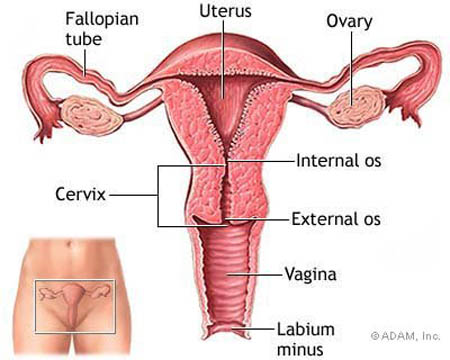Ovaries defintion and function

What are Ovaries, Definition and Function
Ovaries - The female organs of reproduction, also called the female gonads. The ovaries produce OVA (eggs) and sex hormones, predominantly ESTROGENS and PROGESTERONE as well as small amounts of ANDROGENS. A woman has two ovaries, one ovary on each side of the UTERUS in the lower abdomen. Ligaments suspend the ovaries in place within the abdominal cavity. Each ovary is about the size, shape, and consistency of a large olive. At birth it contains the full complement of ova that will supply a woman for all her years of FERTILITY.
The ovary has two distinct layers of structure, an outer cortex and an inner medulla. The ovarian cortex contains the ovarian follicles, each of which holds an immature ovum (egg), also called a GAMETE or germ cell. The fibrous tissue of the ovarian medulla, made up of stroma cells, contains the ovary’s BLOOD vessels, LYMPH vessels, and nerves. The layer of cells covering the ovary is the epithelium; it is made up of epithelial cells (the same type of cell that makes up the SKIN and mucous membranes throughout the body).
Beginning during PUBERTY with the onset of MENSTRUATION, hormonal influences ripen one ovum (sometimes called an oocyte) each MENSTRUAL CYCLE. The ovary releases the ovum into a pocket of fluid that surrounds it. The fimbriae of the fallopian tube (fluted edges of the tube’s open end) float in this fluid, extending toward but not touching the ovary. The undulating movements of the fimbriae pull the released ovum into the fallopian tube where, if SPERM are also present, fertilization may occur.
The PITUITARY GLAND releases FOLLICLE-STIMULATING HORMONE (FSH) and LUTEINIZING HORMONE (LH) at different phases of the menstrual cycle to stimulate the sequence of events that will cause the maturation of an ovum. Several ova typically begin the maturation process during each menstrual cycle though usually only one will complete it. The follicle expels the mature, or ripe, ovum. The cells of the follicle produce estrogens and proteins. The developing ovum is a haploid cell—that is, is contains precisely one half the complement of chromosomes (23) necessary to support human life. When the ovum merges with the sperm, the resulting ZYGOTE contains the full complement of chromosomes (46).
| HEALTH CONDITIONS THAT AFFECT THE OVARIES | |
|---|---|
| ENDOMETRIOSIS | OVARIAN CANCER |
| OVARIAN CYST | POLYCYSTIC OVARY SYNDROME (PCOS) |
| PREMATURE OVARIAN FAILURE (POF) | TURNER’S SYNDROME |
For further discussion of the ovaries within the context of the structures and functions of reproduction and sexuality, please see the overview section “The Reproductive System.” For further discussion of the ovaries within the context of the structures and functions of the endocrine system, please see the overview section “The Endocrine System.”
See also CELL STRUCTURE AND FUNCTION; CONCEPTION; CONTRACEPTION; PREGNANCY; TESTICLES.
Open discussion on the topic Ovaries defintion and function
Similar interests
- Nuovi Casino
- Casinos Not On Gamstop
- UK Casinos Not On Gamstop
- Casinos Not On Gamstop
- UK Casinos Not On Gamstop
- Casino Non Aams Italia
- Slot Sites Not On Gamstop
- Meilleur Casino En Ligne
- Non Gamstop Casino Sites UK
- Meilleur Casino En Ligne
- Casino En Ligne France
- Best Non Gamstop Casinos
- Casinos Not On Gamstop
- UK Casino Not On Gamstop
- Casinos Not Signed Up To Gamstop
- Best Slot Sites UK
- Non Gamstop Casino Sites UK
- Online Casinos Nederland
- Online Casinos Nederland
- Casinos Not On Gamstop
- Best New Uk Casinos Not On Gamstop
- Casino Non Aams
- Non Gamstop Casinos UK